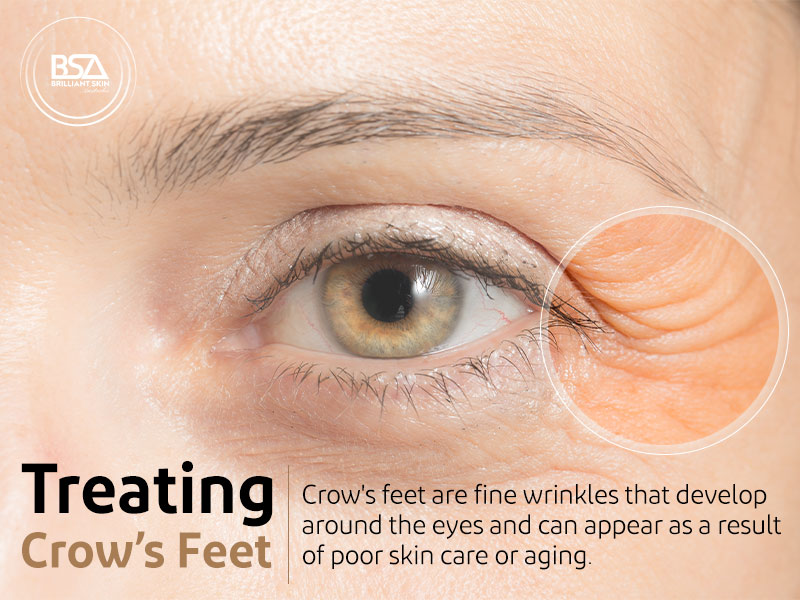Crow’s Feet

Crow’s Feet: Treatment Options and Effectiveness
Overview of Treatments for Crow’s Feet
Crow’s feet, the fine lines around the eyes, can be effectively treated using a variety of methods tailored to their severity and skin condition.
Injectable Treatments
- Botulinum Toxin (Botox, Dysport): This is the most common and effective treatment for dynamic crow’s feet caused by muscle movement. It works by temporarily relaxing the orbicularis oculi muscles, smoothing lines while allowing natural facial expressions. Results appear within 2–14 days and last about 3–4 months. Dysport offers a similar effect with a slightly different spread, often preferred for broader coverage.
- Dermal Fillers: Used to treat static crow’s feet resulting from volume loss. Hyaluronic acid fillers restore volume and hydrate the skin, softening wrinkles. Results are immediate and last 6–12 months.
Skin Resurfacing and Topicals
- Chemical Peels: Remove damaged outer skin layers and stimulate collagen production, effectively reducing fine lines and promoting smoother skin. Types range from superficial to deep peels, with corresponding downtime and results.
- Laser Resurfacing: Ablative and non-ablative lasers stimulate collagen remodeling, improving skin texture and tightness. This can be combined with Botox for enhanced results.
- Microneedling: Induces collagen synthesis through controlled micro-injuries, improving skin firmness and reducing wrinkles.
- Topical Retinoids and Antioxidants: Promote collagen production and provide antioxidant protection, supporting long-term skin health and wrinkle prevention.
Prevention
- Consistent use of broad-spectrum sunscreen with SPF 30+
- Avoiding excessive sun exposure and smoking
- Hydrating the delicate eye area regularly
- Correcting vision problems to reduce squinting
Effectiveness and Considerations
- Botox and Dysport show over 90% efficacy in reducing dynamic wrinkles with quick, minimal downtime procedures.
- Dermal fillers provide natural-looking volume restoration especially suitable for deeper lines.
- Laser and chemical peels offer longer-lasting skin quality improvement but require more recovery time.
- Combination treatments often yield superior, natural-looking rejuvenation.
Consult with Our Team of Experts Now!
For a comprehensive evaluation and personalized treatment plan addressing your crow’s feet, consult with our board-certified dermatologists and cosmetic specialists to choose the best option suited to your needs.
References:
- Zimbler MS, Trattner A, Kostyra M. Combined Use of Botulinum Toxin A and Laser Therapy is More Efficacious for Crow’s Feet: A Prospective Randomized Blinded Trial. Arch Facial Plast Surg. 2023 Jul 9;25(4):350-358. doi:10.1001/archfacial.2023.01030. Available at: https://www.ncbi.nlm.nih.gov/pmc/articles/PMC10501743/
- Yamauchi PS, Ibrahim O, Al-Attar A. Adjunctive Benefit of Botulinum Toxin Type A with Ablative Laser Resurfacing in Periorbital Rhytids: Randomized Controlled Trial. J Cosmet Laser Ther. 2009 Sep;11(3):121-127. doi:10.1080/14764170902972353. Available at: https://doi.org/10.1080/14764170902972353
- Mahmoud BH, Kimyai-Asadi A. Botulinum Toxin Pretreatment Enhances Outcomes of Fractional CO2 Laser Resurfacing for Crow’s Feet: A Randomized Controlled Trial. Dermatol Surg. 2015 Jun;41(6):722-728. doi:10.1097/DSS.0000000000000332. Available at: https://www.ncbi.nlm.nih.gov/pmc/articles/PMC10374187/
- Fan Y, Li Y, et al. Safety and Effectiveness of Nonablative Fractional Laser Combined with Transdermal Botulinum Toxin A for Periocular Wrinkles: Prospective Study. Plast Reconstr Surg Glob Open. 2016 May;4(5):e621. doi:10.1097/GOX.0000000000000621. Available at: https://www.ncbi.nlm.nih.gov/pmc/articles/PMC4421377/
- Carruthers J, Carruthers A. Botulinum Toxin Type A (Botox) for Treatment of Crow’s Feet. Dermatol Clin. 2022 May;40(2):149-158. doi:10.1016/j.det.2021.12.007. Available at: https://doi.org/10.1016/j.det.2021.12.007















